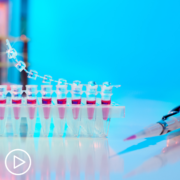Essential Testing in AML: How Results Impact Care & Treatment Choices
Essential Testing in AML: How Results Impact Care & Treatment Choices from Patient Empowerment Network on Vimeo.
What tests should follow an AML diagnosis and why? Dr. Hetty Carraway, an AML specialist of Cleveland Clinic, reviews the essential testing for patients with AML and explains how those test results may inform treatment decisions.
Dr. Hetty Carraway is Director of the Leukemia Program at Cleveland Clinic. Dr. Carraway cares for patients with acute leukemia and bone marrow failure states. Learn more about Dr. Carraway, here.
Related Resources:

What Is the Patient’s Role in Making AML Treatment Decisions? |

|

|
Transcript:
Katherine:
Hello, and welcome. I’m Katherine Banwell. Today, we’ll discuss how you can be proactive by insisting on better AML care and personalized treatment options. Joining me is Dr. Hetty Carraway.
Welcome, Dr. Carraway. Would you please introduce yourself?
Dr. Carraway:
Hi. My name is Dr. Hetty Carraway. I’m one of the physicians at the Cleveland Clinic. I work as the Director of the Leukemia Program, and I spend most of my time caring for patients with acute leukemia and bone marrow failure states.
Katherine:
Thank you. Let’s start with the basics. What essential testing should AML patients undergo following a diagnosis?
Dr. Carraway:
This is a pretty standard workup for patients that have this diagnosis of acute leukemia.
For most of our patients we always evaluate with a peripheral blood count including a complete blood count with differential, typically a comprehensive metabolic panel, and looking at a test called a uric acid, which looks at the cell turnover and the cellular debris in terms of the burden on the kidney. We often will get a bone marrow biopsy with aspirate for patients, and in the diagnosis of leukemia typically that’s already been done.
There are tests that are sent off of that aspirate called a test for chromosomes, whether it’s comprehensive cytogenetics or FISH, for fluorescence in situ hybridization. We’re often testing using a study called NGS or next generation sequencing looking for specific mutations of genes known to be important in the pathogenesis of leukemia.
Furthermore, we often get a test called flow cytometry from that aspirate looking at the markers on top of the leukemia cells that help us to identify the blast population. So, I would say those by and large are the tests in the bone marrow biopsy that we get, which are innumerable and detailed.
They often take some time to get back, so at the time of the diagnosis patients know that they have a diagnosis of leukemia, but those additional chromosome tests or mutation testing that can take up to two weeks if not longer to get back. And so, it’s important to follow up on that information later on and say, has that testing come back? If so, how does that change any of what the decisions are moving forward?
Katherine:
Genetic testing can often be confused with molecular testing. What’s the difference between the two, and why should patients undergo the testing?
Dr. Carraway:
The chromosome testing and the mutational testing help us to really classify the risk in terms of the leukemia itself, whether or not that leukemia is responsive to chemotherapy alone, or if it means that there’s a higher likelihood of that leukemia not being controlled with leukemia only.
In that setting, we often then move towards transplant for curative intent in addition to the chemotherapy. The reasons to get the information is to really help us better tailor the therapy for each individual patient. That information really does help us guide not only the upfront therapy for some patients but even the long-term therapy. It can be incredibly overwhelming to have too much information at the get-go, so in some senses it’s better to have these pieces as they unfold over time.
For other patients, they want to know what exactly the plan is going to be A to Z from day one. That is of course more challenging now that it just takes time to get this information. I think what they need to know is that we’re working hard to get that information.
As soon as we get it, we don’t hold back. We reveal and share that information and come together to say, this is what this data or information means, and these are some of the choices that we either recommend that you consider, and these are the risks and benefits to those considerations.
Katherine:
Let’s look at something that is similar to what you’ve just been talking about. How do test results impact treatment and overall care?
Dr. Carraway:
They really can. When you asked me how come chromosome or genetic information is different than mutational information, the chromosomes can help us to figure out where patients land in terms of prognosis. That information is different than the mutational testing. Both of those pieces can help us figure that out.
The mutational test, I will tell you, does help us figure out are there targets on the leukemia that allow us to use therapy that’s directed to that mutation. The key example I’ll give is a mutation in a gene called FLT3. That particular mutation has an agent now that is F.D.A. approved called Midostaurin, and so once we know that a leukemia harbors a FLT3 mutation we often add a drug called Midostaurin to the backbone therapy that is used for patients.
Now, that’s important, and now there are more and more genes that when mutated we have novel therapies that direct against that specific tag that’s on the leukemia and helps to improve eradication of the disease or control of the disease if you will.
That’s different than the genetic information when we’re looking at chromosomal changes that may allow us to say in the rare instances of favorable cytogenetics like a translocation of chromosome 15 and 17 consistent with APL, the treatment for that type of leukemia, acute promyelocytic leukemia, is very different than what we do for the majority of other leukemias.
The prognosis for that leukemia is also very different. It helps to tailor the regimens, and it helps to select specific therapy that may be helpful to each individual patient.
Katherine:
Dr. Carraway, you just mentioned FLT3. Would you tell us about the common mutations in AML and how these may impact treatment options?
Dr. Carraway:
There’s a multitude of mutations that we’re now following in patients. The way that we follow them is by doing this next generation sequencing test at the upfront time at diagnosis.
The reason why we’re doing that is because those mutations can regress with therapy, or they can progress where you gain additional mutations that happen as the disease progresses. Even if it’s responding to therapy or as it loses response to therapy and reemerges, it may reemerge with different mutations. As a result of that, it may change what therapy we select. Our ability at this point in being to recommend exactly at what time points we are checking the next generation sequencing we’re still learning right now as to what are the key times to do that testing.
In general, most institutions are doing that next generation sequencing at the time of diagnosis, and then also for some patients before they go to bone marrow transplant and even after bone marrow transplant.
For some of those patients that unfortunately relapse, we’re also making sure to retest the next generation sequencing mutation testing to see are there new mutations that have come about that weren’t there before?
Katherine:
I understand there’s something called IDH.
Dr. Carraway:
You were also asking about what other mutations besides FLT3 happen in patients with AML. FLT3 is one such mutation. NPM1 is another mutation that often it frequents patients that have AML. Those two mutations happen in about 30 percent of patients with AML. There are other mutations such as DNMT3A, ASXL1, and TET2 that we typically see in patients with MDS or even a pre-leukemia state called CHIP. For other patients, we have mutations that are targetable like IDH1 or IDH2.
Those two mutations happen in probably 10 percent to 15 percent of patients diagnosed with AML. Why are those important? They’re important because we have oral medications that are pills that patients can take. In the relapse setting for many patients after induction or intensive chemotherapy, they can use these oral therapies to try and control their leukemia. These are pretty exciting.
All of these oral therapies have been approved in the last two to three years in the space of leukemia, so it’s been a game-changer in terms of identifying these mutations and then identifying drugs that target those mutations. It’s really changed the landscape for patients with AML. It’s new information, and that’s why as patients you want to hear about this so you know what questions to ask and you know, can you tell me, am I a candidate for one of these oral medications that is now available for patients with AML?
Katherine:
Dr. Carraway, thanks so much for joining us today.
Dr. Carraway:
Thank you for the opportunity to be here.
Katherine:
And thank you to our audience. I’m Katherine Banwell.




















